Glass Manufacturer Financial Model
Here’s a comprehensive breakdown of the 20 Year Excel Financial Models for a Glass Manufacturer, covering the Income Statement, Cash Flow Statement, and Balance Sheet. With revenues from 80 product lines and a Subscription Add-On. Cost structures, and financial statements to forecast the financial health of your Glass Manufacturing.
Financial Model for a Glass Manufacturer
Covering key components such as the Income Statement, Cash Flow Statement, and Balance Sheet.
Income Statement
The Income Statement projects revenues, costs, and profitability over time. It is broken down by product lines and consolidated for the entire business.
Revenue
Smaller Product Lines: Revenue is calculated based on the volume of glass products sold (e.g., tons or units) multiplied by the selling price per unit. Include assumptions for volume growth and price changes over time.
80 Product Line: With separate assumptions for volume and pricing specific to this product category.
Total Revenue: Sum of revenues from both product lines.
Cost of Goods Sold (COGS)
Smaller Product Lines: Might include raw material costs (e.g., silica, soda ash), labor, and manufacturing overhead specific to this product line. Calculate as a percentage of revenue or per unit cost.
80 Product Line: Separate COGS calculation for this product line, reflecting its unique cost structure.
Total COGS: Sum of COGS for both product lines.
Gross Profit
80 Product Line: Revenue minus COGS for this product line.
Total Gross Profit: Sum of gross profits from both product lines.
Operating Expenses
Fixed Costs: Rent, utilities, salaries for administrative staff, and other overhead costs.
Variable Costs: Marketing, distribution, and other costs that scale with production or sales.
R&D Expenses: Costs related to developing new glass products or improving existing ones.
Total Operating Expenses: Sum of all fixed and variable costs.
Operating Income (EBIT)
80 Product Line: Gross profit minus allocated operating expenses.
Total Operating Income: Sum of operating income from both product lines.
Net Income
Interest Expense: Cost of debt financing.
Taxes: Applicable corporate tax rate applied to pre-tax income.
Net Income: Operating income minus interest and taxes.
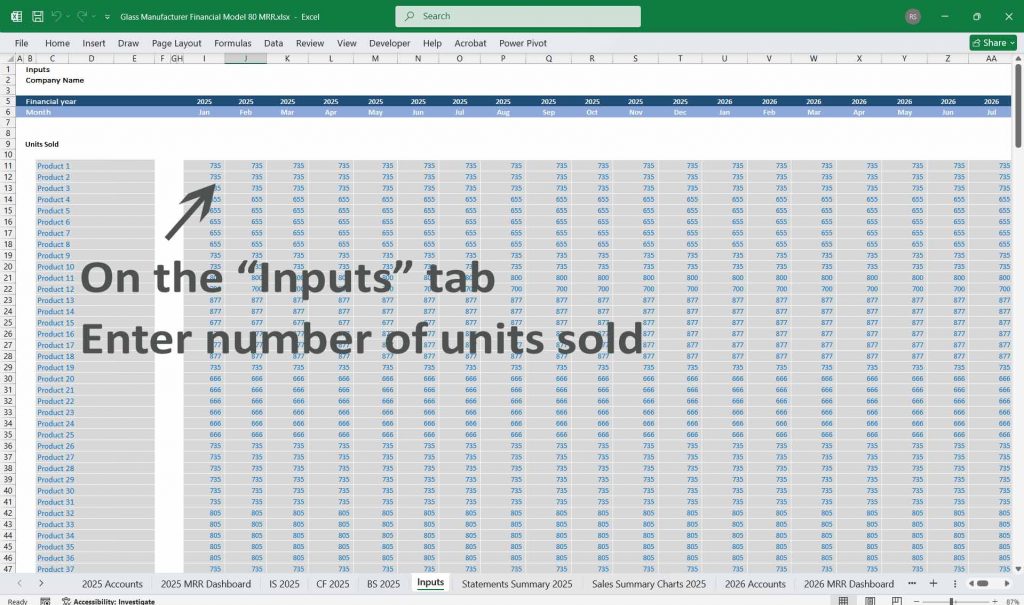
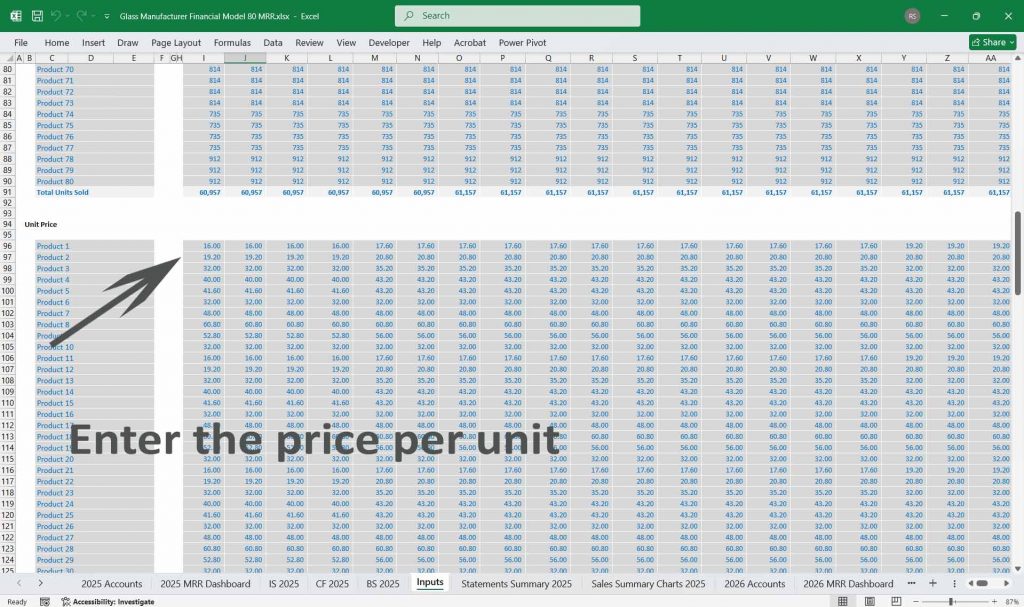
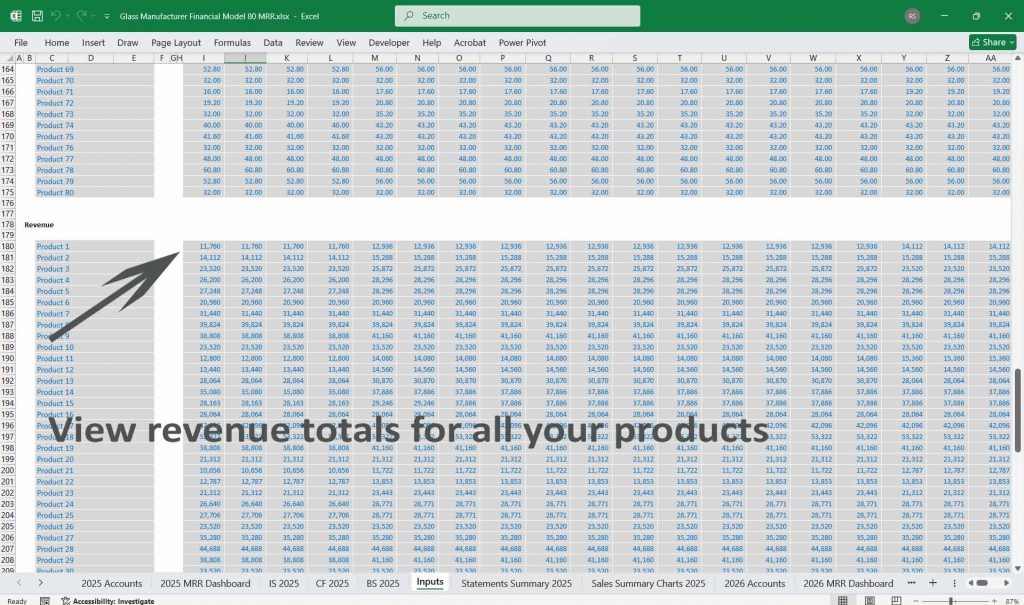
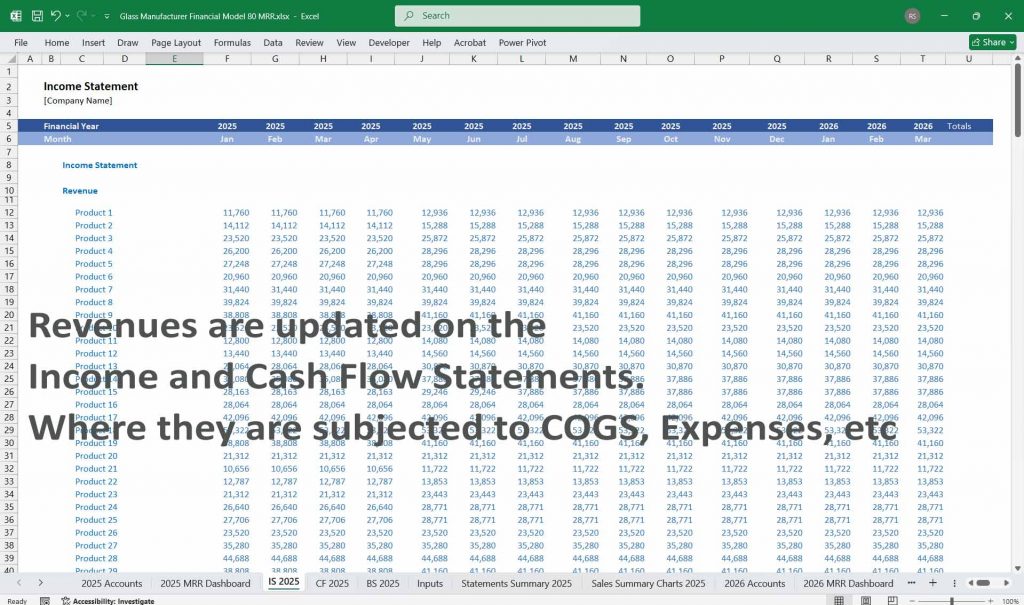
Glass Manufacturer Cash Flow Statement
The Cash Flow Statement tracks the company’s cash inflows and outflows, broken into operating, investing, and financing activities.
Operating Activities
Cash from Sales: Cash received from customers for both product lines.
Cash Paid for COGS: Cash outflows for raw materials, labor, and manufacturing costs.
Operating Expenses: Cash outflows for fixed and variable costs.
Net Cash from Operations: Cash from sales minus cash paid for COGS and operating expenses.
Investing Activities
Capital Expenditures (CapEx): Investments in new machinery, equipment, or facilities for both product lines.
R&D Investments: Cash spent on developing new products or improving existing ones.
Net Cash Used in Investing: Total CapEx and R&D investments.
Financing Activities
Debt Issuance/Repayment: Cash inflows from new debt or outflows from debt repayment.
Equity Issuance: Cash inflows from issuing new shares.
Dividends: Cash outflows for shareholder dividends.
Net Cash from Financing: Total cash inflows/outflows from financing activities.
Net Change in Cash
Sum of net cash from operations, investing, and financing activities.
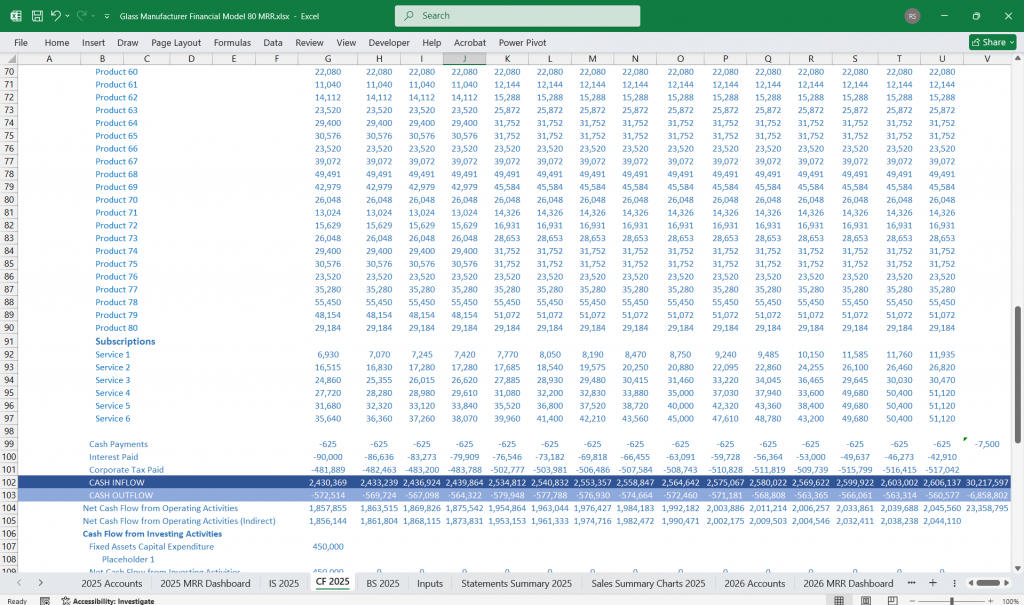
Glass Manufacturer Balance Sheet
The Balance Sheet provides a snapshot of the company’s financial position at a specific point in time.
Assets
Current Assets:
Cash: Ending cash balance from the Cash Flow Statement.
Accounts Receivable: Outstanding payments from customers.
Inventory: Raw materials, work-in-progress, and finished goods for both product lines.
Non-Current Assets:
Property, Plant, and Equipment (PP&E): Net of depreciation for manufacturing facilities and equipment.
Intangible Assets: Patents or trademarks related to glass products.
Liabilities
Current Liabilities:
Accounts Payable: Outstanding payments to suppliers.
Short-Term Debt: Debt due within one year.
Non-Current Liabilities:
Long-Term Debt: Debt due after one year.
Equity
Shareholder Equity: Common stock, retained earnings, and additional paid-in capital.
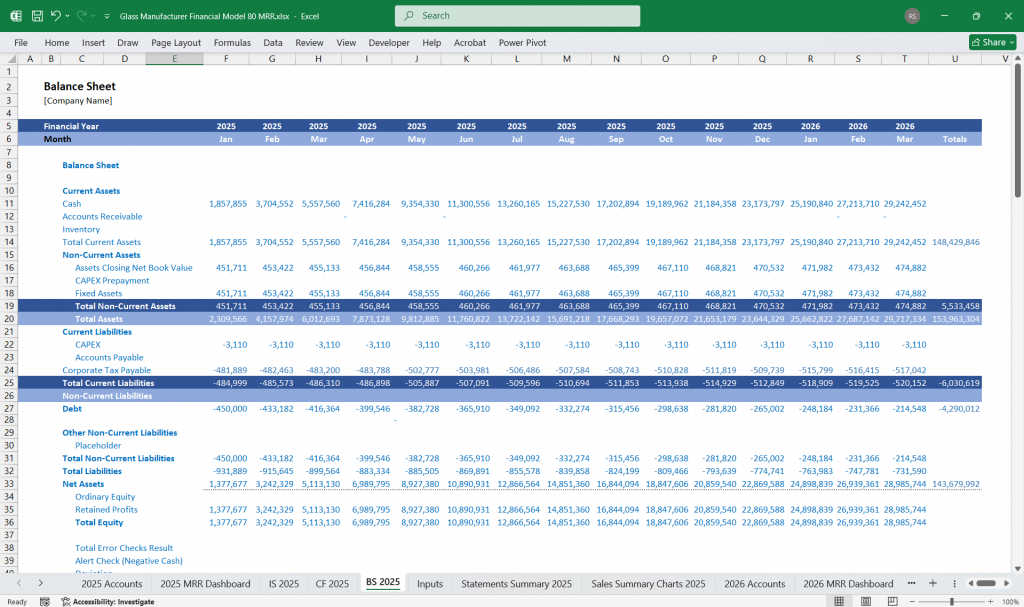
Key Financial Metrics for a Glass Manufacturer
- Gross Profit Margin = (Gross Profit / Revenue) × 100
- Operating Profit Margin (EBIT Margin) = (EBIT / Revenue) × 100
- Net Profit Margin = (Net Income / Revenue) × 100
- Return on Assets (ROA) = (Net Income / Total Assets) × 100
- Return on Equity (ROE) = (Net Income / Shareholder Equity) × 100
- Debt-to-Equity Ratio = (Total Debt / Shareholder Equity)
- Inventory Turnover = (COGS / Average Inventory)
- Days Sales Outstanding (DSO) = (Accounts Receivable / Revenue) × 365
When structuring product lines for a glass manufacturer, it’s important to organize them in a way that aligns with customer needs, market demand, and operational efficiency. Below are detailed sections for 80 product lines, including categorization, examples, and strategic considerations.
Product Line Categorization for a Glass Manufacturer
A Glass Manufacturer typically produces a wide range of products for different industries, including construction, automotive, consumer goods, and specialty applications.
1. Smaller Product Line Breakdown
Category 1: Architectural & Construction Glass (10 Products)
- Tempered Glass – High-strength, impact-resistant glass for windows and doors
- Laminated Glass – Safety glass with interlayer for impact resistance
- Insulated Glass (Double/Triple Glazing) – Energy-efficient, thermal insulation glass
- Low-E Glass (Low-Emissivity Coating) – Reduces heat transfer and UV exposure
- Frosted Glass – Aesthetic and privacy-focused applications
- Tinted Glass – Reduces glare and heat for buildings and vehicles
- Mirrored Glass – Reflective glass for decorative and functional uses
- Fire-Rated Glass – Heat-resistant glass for fire doors and safety applications
- Soundproof Glass (Acoustic Laminated Glass) – Reduces noise transmission
- Self-Cleaning Glass – Hydrophobic or photocatalytic coatings for maintenance reduction
Category 2: Automotive Glass (8 Products)
- Windshield Glass – Laminated safety glass for vehicles
- Side Window Glass (Tempered) – Durable and shatter-resistant glass
- Rear Window Glass – Often laminated or tempered with defogging elements
- Sunroof Glass – UV-resistant and heat-reflective glass
- Head-Up Display (HUD) Glass – Specialized glass for digital windshield displays
- Privacy Glass (Dark-Tinted Windows) – Enhances vehicle aesthetics and privacy
- Solar Control Glass – Heat-resistant automotive glass
- Bulletproof Glass – Multi-layered laminated glass for armored vehicles
Category 3: Consumer & Interior Glass (7 Products)
- Tabletop Glass – Clear, frosted, or tempered glass for furniture
- Shower Enclosure Glass – Water-resistant, tempered glass for bathrooms
- Glass Partitions – Office and home dividers with different opacities
- Stained Glass – Decorative and artistic glass
- Glass Flooring & Stairs – Tempered and laminated for safety
- Glass Shelving – Used in furniture and retail displays
- Smart Glass (Switchable Privacy Glass) – Electrochromic technology for dynamic transparency
Category 4: Industrial & Specialty Glass (8 Products)
- Solar Panel Glass – High-transparency, low-iron glass for solar energy
- LCD/OLED Display Glass – High-clarity, scratch-resistant glass for screens
- Photovoltaic Glass – Embedded with solar cells for energy generation
- UV-Blocking Glass – Used in museums and medical applications
- Chemical-Resistant Glass – Laboratory and industrial applications
- Borosilicate Glass – Heat-resistant for cookware and laboratory use
- Glass for Greenhouses – UV-optimized for plant growth
- Aerospace Glass – Used in aircraft windows and space applications
Category 5: Decorative & Custom Glass (7 Products)
- Engraved Glass – Personalized and etched designs
- Beveled Glass – Decorative edge treatments for aesthetics
- Patterned Glass – Textured and embossed glass surfaces
- Glass Tiles – Used in interior design and mosaics
- Back-Painted Glass – Custom-colored glass for walls and kitchens
- Antique/Reclaimed Glass – Repurposed glass with unique textures
- Digital Printed Glass – High-resolution images on glass surfaces
2. 80-Product Line Breakdown
For an 80-product breakdown, we expand each category into more subtypes and specialty applications.
Category 1: Architectural & Construction Glass (20 Products)
1-10. Same as Above
11. Triple-Laminated Glass – Extra safety layer for hurricane resistance
12. Anti-Reflective Glass – Used in high-visibility applications
13. Wire-Reinforced Glass – Fire-resistant applications
14. Curved Glass – Specialty architectural applications
15. Electrochromic Smart Glass – Automated light/dark tinting
16. Vacuum-Insulated Glass – Extreme energy efficiency
17. Photochromic Glass – Tint changes with sunlight intensity
18. Anti-Microbial Glass – Coated to reduce bacterial growth
19. Transparent Aluminum Glass – Ultra-durable, shatterproof glass
20. One-Way Vision Glass – Privacy applications for surveillance
Category 2: Automotive Glass (15 Products)
1-8. Same as Above
9. Heated Windshield Glass – Eliminates fog and ice buildup
10. UV-Filtering Windshield – Enhances driver comfort
11. Convertible Rear Window Glass – Flexible and shatterproof
12. Augmented Reality (AR) Windshield – Digital overlays for navigation
13. Aerodynamic Glass (Low Drag Coefficient) – Optimized for performance cars
14. Motorcycle Helmet Visor Glass – Scratch-resistant and anti-fog
15. Electric Vehicle (EV) Glass – Optimized for weight reduction and efficiency
Category 3: Consumer & Interior Glass (15 Products)
1-7. Same as Above
8. Fingerprint-Resistant Glass – Anti-smudge coatings
9. Anti-Glare Glass – Used in monitors and eyeglasses
10. Ultra-Thin Glass – Used in flexible electronics
11. Glass Balustrades – Railings for staircases and balconies
12. Illuminated Glass Panels – Embedded LED lighting
13. UV-Enhanced Aquarium Glass – Designed for marine life preservation
14. Hybrid Metal-Glass Composites – Used in luxury design
15. Copper-Infused Glass – Antimicrobial surfaces for hospitals
Category 4: Industrial & Specialty Glass (15 Products)
1-8. Same as Above
9. Graphene-Enhanced Glass – Conductive and ultra-strong
10. Magnetron-Sputtered Glass – Coated for high-performance optics
11. IR-Blocking Glass – Defense and infrared-sensitive applications
12. Holographic Display Glass – Used in augmented reality systems
13. Lead Glass (Radiation Shielding) – X-ray and nuclear applications
14. Laser Protection Glass – Safety applications in industrial settings
15. Anti-Static Glass – Used in cleanrooms and laboratories
Category 5: Decorative & Custom Glass (15 Products)
1-7. Same as Above
8. Opalescent Glass – Soft, milky appearance for artistic uses
9. 3D Textured Glass – Advanced designs for unique aesthetics
10. Fluted Glass – Vertical grooves for architectural appeal
11. Gold-Leafed Glass – Luxury applications
12. Carbon Fiber-Embedded Glass – Strength-enhanced decorative uses
13. Laser-Engraved Holographic Glass – Interactive display applications
14. Water-Reactive Glass – Changes color when exposed to moisture
15. High-Resolution Projection Glass – Used in digital advertising
Conclusion
This 80 product line breakdown provides a detailed view of the glass manufacturing industry, categorizing products by construction, automotive, consumer, industrial, and decorative applications.
6-tier subscription model for a Glass manufacturer
This involves structuring offerings that cater to different customer segments, from small businesses to large enterprises. Each tier should provide increasing value, services, and benefits to justify the higher price points.
1. Basic Tier: “Essential Glass Supply”
Target Audience: Small businesses, startups, or occasional buyers.
Features:
Monthly Glass Supply: Fixed volume of standard glass products (e.g., 10 tons/month).
Product Types: Basic glass types (e.g., clear float glass, tempered glass).
Delivery: Standard delivery (7-10 business days).
Pricing: Low-cost, fixed monthly fee with no customization.
Support: Email support during business hours.
Discounts: 5% discount on additional orders beyond the subscription volume.
Value Proposition:
Affordable, predictable costs for small-scale buyers.
Reliable supply of essential glass products.
2. Standard Tier: “Flexible Glass Solutions”
Target Audience: Medium-sized businesses with moderate glass needs.
Features:
Monthly Glass Supply: Adjustable volume (e.g., 20-50 tons/month).
Product Types: Standard and some specialty glass (e.g., laminated glass, low-E glass).
Delivery: Priority delivery (3-5 business days).
Pricing: Tiered pricing based on volume, with a 10% discount on subscription volume.
Support: Dedicated account manager and phone support.
Customization: Limited customization options (e.g., size, thickness).
Value Proposition:
Flexibility to adjust volume and access to specialty products.
Cost savings through volume discounts.
3. Premium Tier: “Advanced Glass Solutions”
Target Audience: Large businesses or industries with high glass demand (e.g., construction, automotive).
Features:
Monthly Glass Supply: High volume (e.g., 50-200 tons/month).
Product Types: Advanced glass types (e.g., insulated glass, fire-resistant glass).
Delivery: Expedited delivery (1-3 business days).
Pricing: Volume-based pricing with a 15% discount on subscription volume.
Support: 24/7 dedicated support and technical assistance.
Customization: Full customization options (e.g., coatings, tints, shapes).
Value Proposition:
High-volume supply with advanced customization.
Priority delivery and premium support.
4. Enterprise Tier: “Tailored Glass Solutions”
Target Audience: Large corporations or specialized industries with unique requirements.
Features:
Monthly Glass Supply: Custom volume based on demand.
Product Types: Bespoke glass solutions (e.g., bulletproof glass, UV-resistant glass).
Delivery: Guaranteed next-day delivery.
Pricing: Negotiated pricing with a 20% discount on subscription volume.
Support: On-site technical support and consulting services.
Customization: Fully tailored solutions, including R&D collaboration.
Value Proposition:
Fully customized glass products and services.
Exclusive benefits for high-value clients.
5. Sustainability Tier: “Eco-Friendly Glass Solutions”
Target Audience: Environmentally conscious businesses or industries.
Features:
Monthly Glass Supply: Custom volume of eco-friendly glass products.
Product Types: Recycled glass, energy-efficient glass, or low-carbon footprint glass.
Delivery: Carbon-neutral delivery options.
Pricing: Premium pricing with a 10% discount for long-term commitments.
Support: Sustainability consulting and reporting.
Customization: Customizable eco-friendly options (e.g., recycled content, energy-efficient coatings).
Value Proposition:
Access to sustainable glass products and services.
Alignment with corporate sustainability goals.
6. On-Demand Tier: “Pay-As-You-Go Glass Solutions”
Target Audience: Businesses with irregular or unpredictable glass needs.
Features:
Monthly Glass Supply: No fixed volume; pay only for what is used.
Product Types: Access to all glass types (standard, specialty, and custom).
Delivery: Flexible delivery options (standard, priority, or expedited).
Pricing: Pay-as-you-go pricing with no subscription fee.
Support: Basic email and phone support.
Customization: Limited customization options.
Value Proposition:
No commitment; ideal for businesses with fluctuating demand.
Access to a wide range of glass products without long-term contracts.
- Additional Considerations Across Tiers
Scalability:
Each tier is designed to be scalable, allowing customers to upgrade as their production needs grow.Integration & API Access:
Higher tiers offer greater levels of system integration, enabling seamless connectivity with in-house systems and real-time tracking.Flexibility:
Options for rollover of unused print credits and flexible overage billing ensure that customers only pay for what they need.Value-Added Services:
Complimentary design consultations, technical support, and training workshops become more prominent in the higher tiers, adding strategic value beyond just production capacity.Service Level Agreements (SLAs):
Defined SLAs across tiers provide transparency regarding turnaround times, quality standards, and uptime guarantees, with the most rigorous SLAs reserved for Enterprise and Premium tiers.
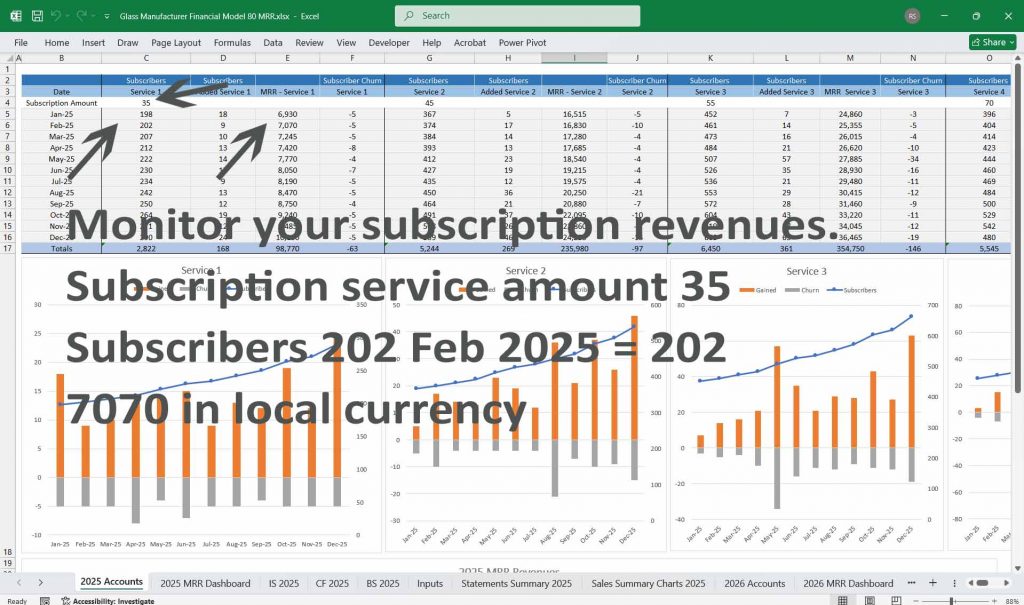
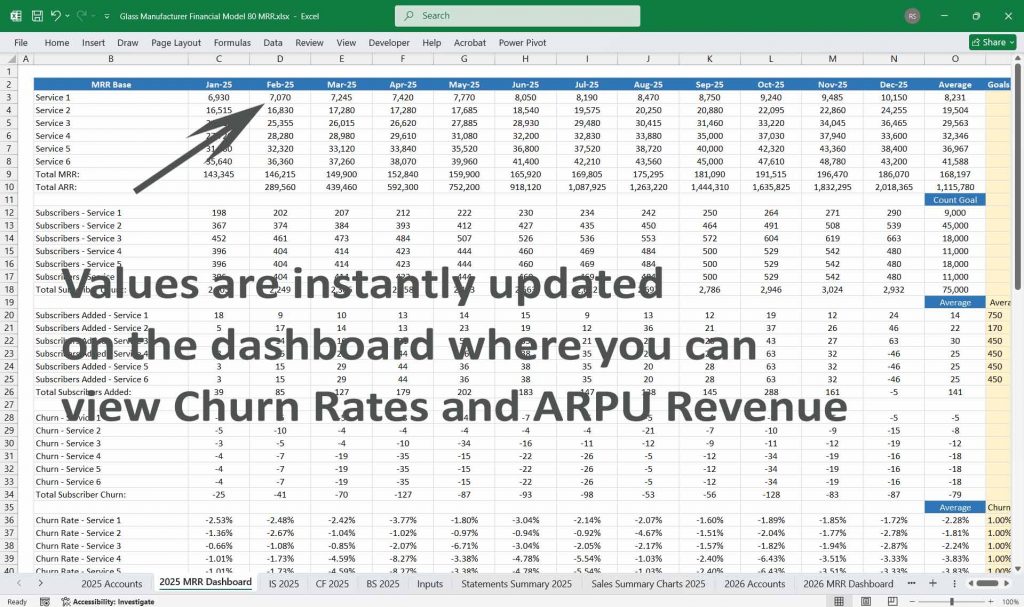
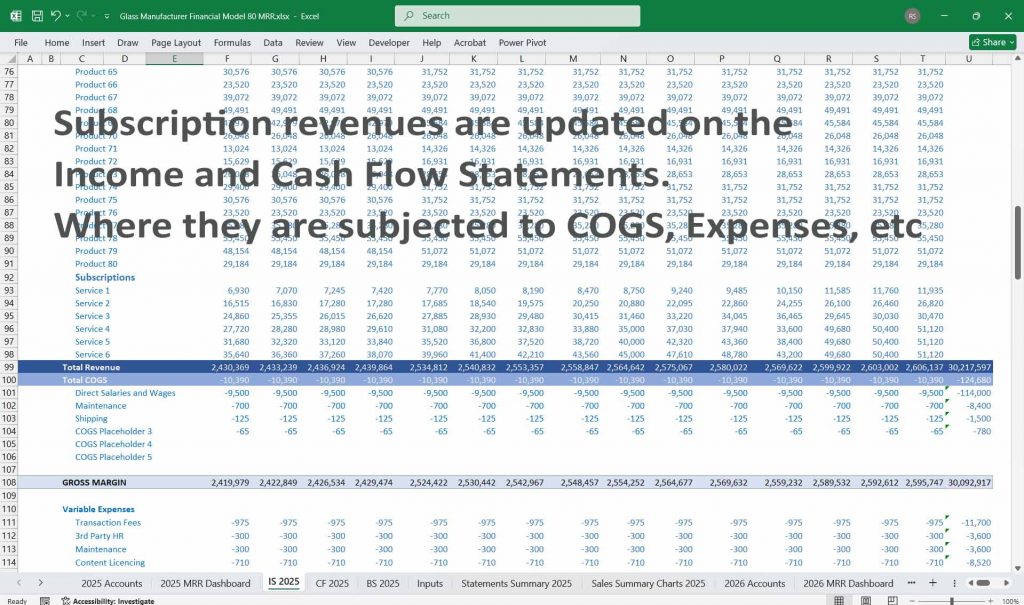
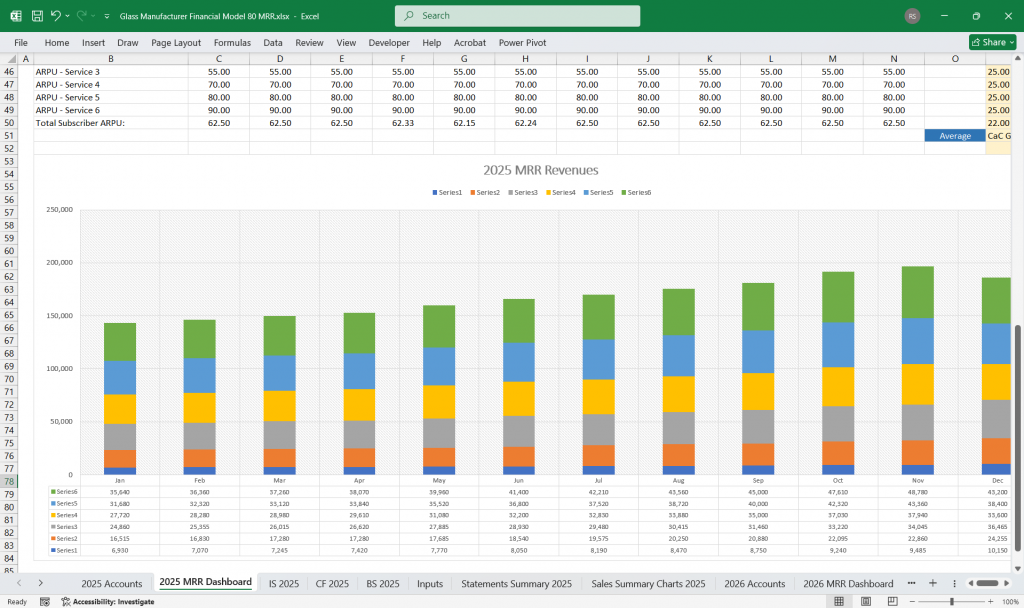
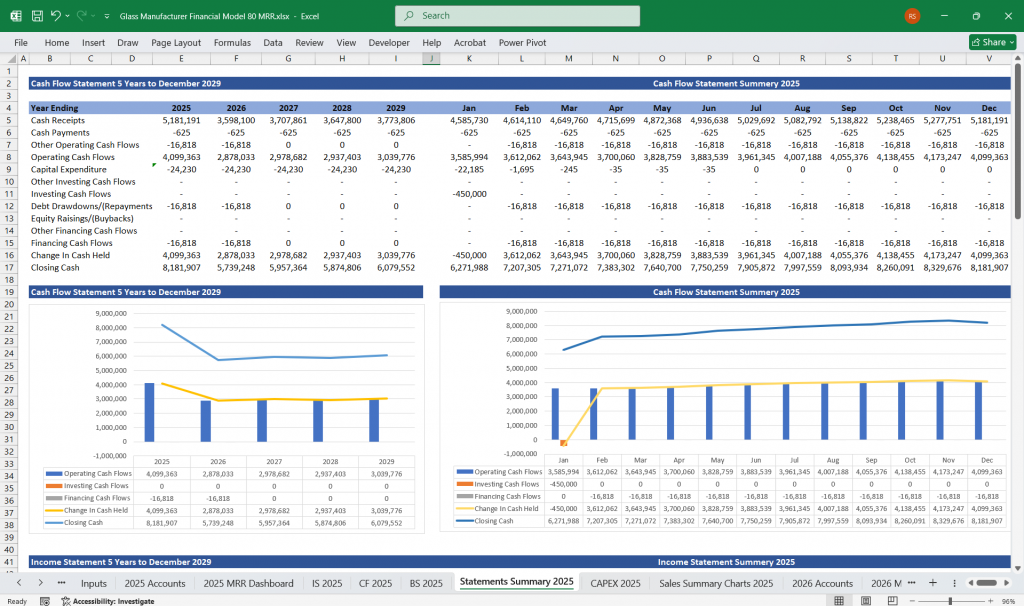
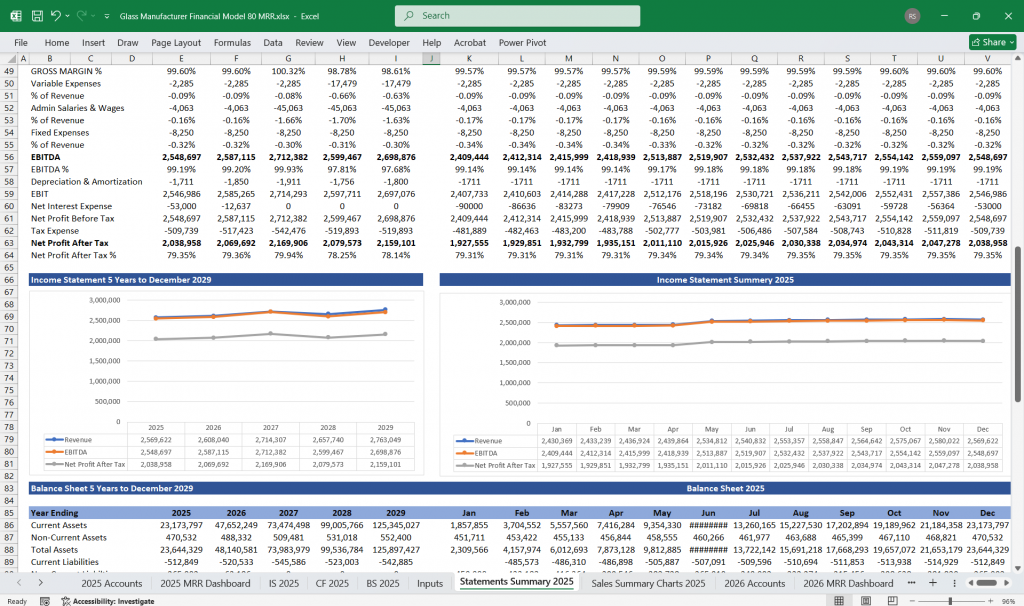
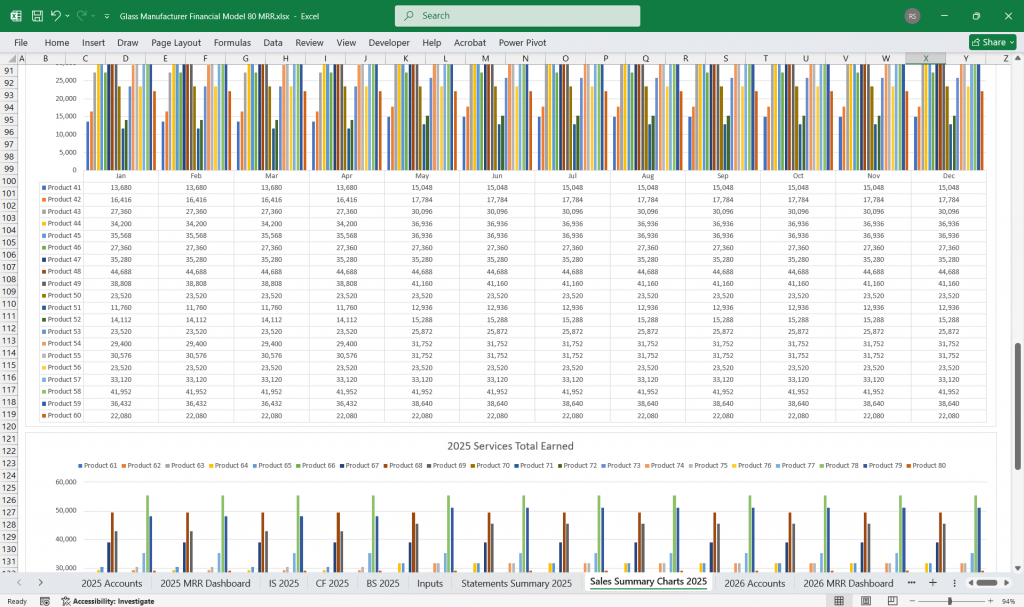
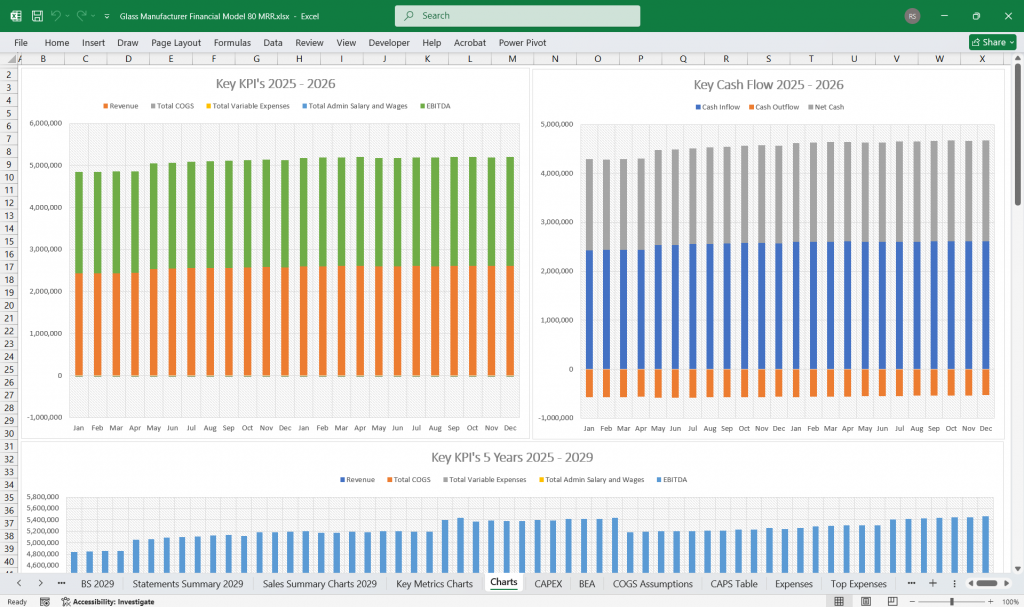
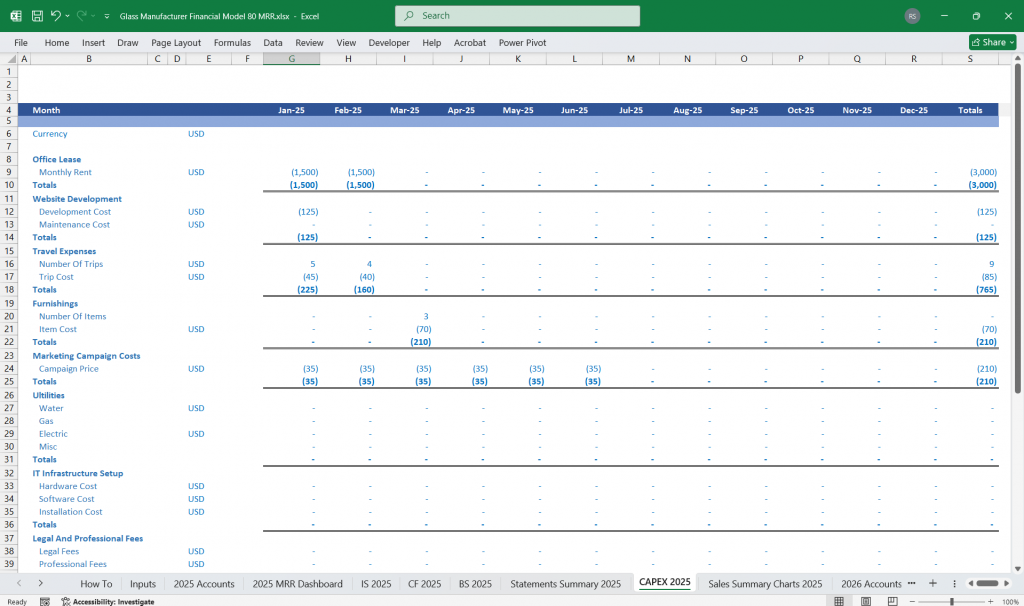
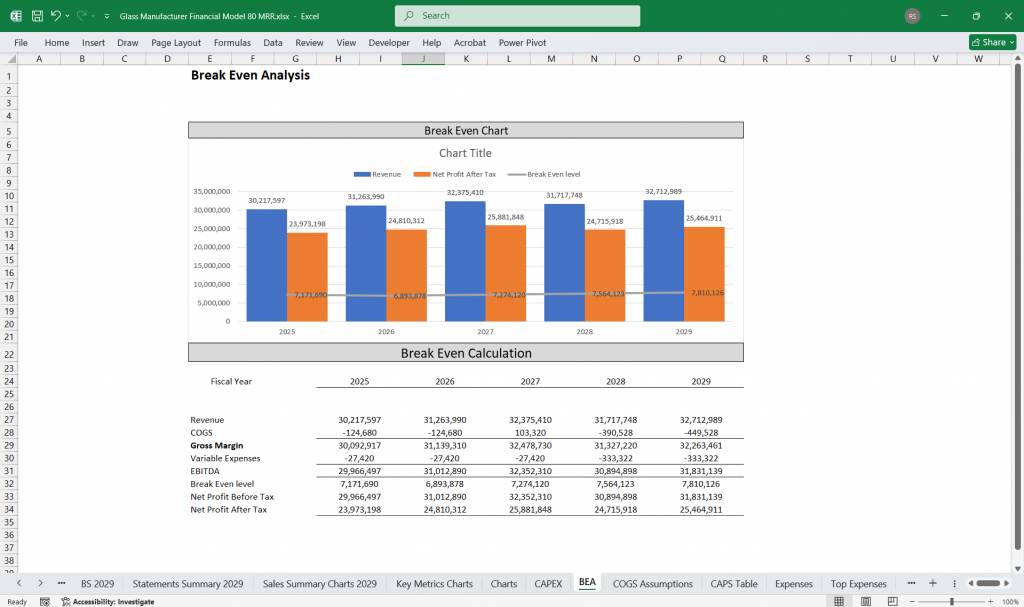
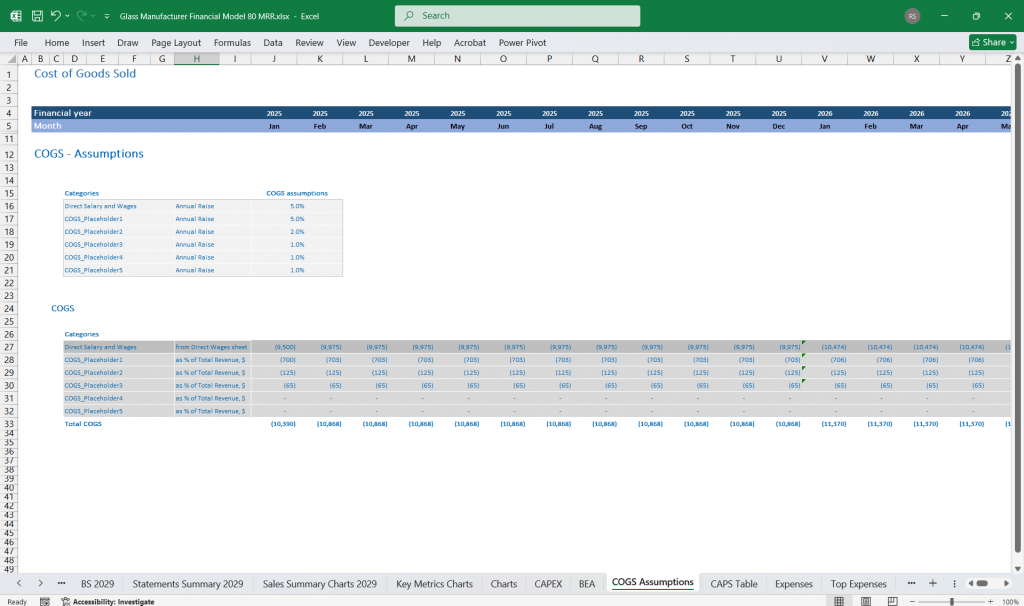
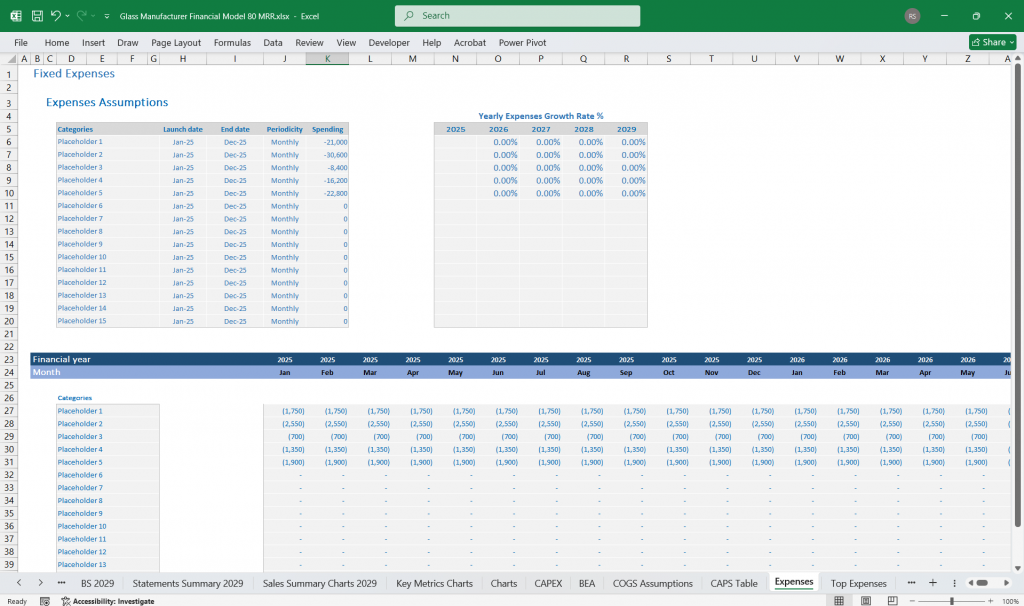
Final Notes on the Financial Model
Financial model for a Glass manufacturer
- Scenario Analysis: Create best-case, base-case, and worst-case projections.
- Break-even Analysis: Determine sales volume required to cover fixed & variable costs.
- Sensitivity Analysis: Assess how changes in raw material costs, pricing, or demand impact profitability.
This structured model helps a Glass manufacturing business address a broad market spectrum, offering the right balance between cost, production capacity, support, and customization at each subscription level.
Download Link On Next Page
